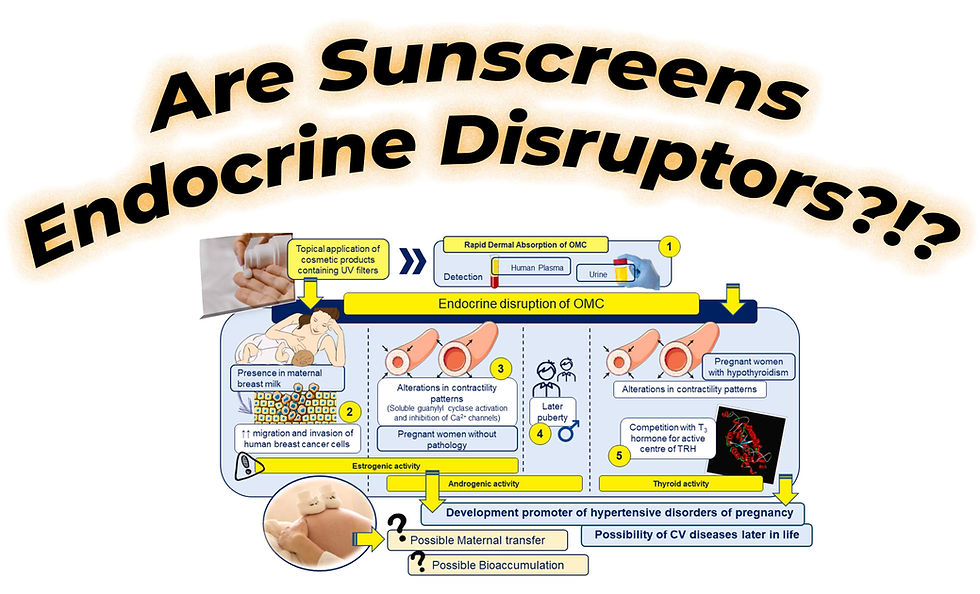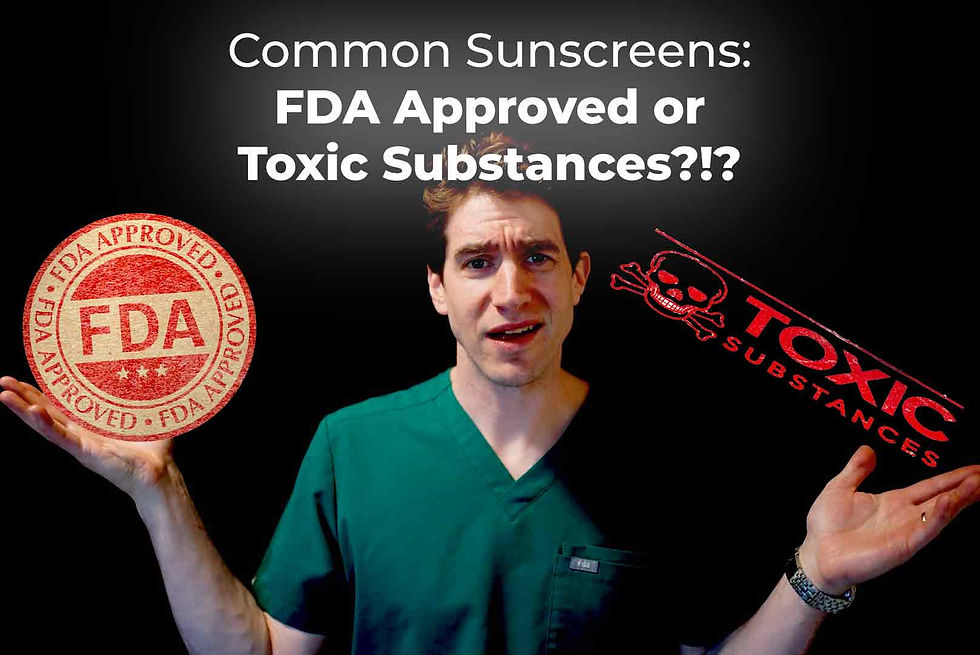What's in Sunlight (and Why Do We Care)?
- Ryan M. Trowbridge, MD, MS, MA

- Mar 19
- 7 min read
Updated: Mar 23
Introduction
The sun emits a lot: light, heat, solar particles, magnetic fields, solar flares, etc. But dermatologists seem most interested in light, and specifically ultraviolet (UV) light.
Ultraviolet light (radiation) is broken up into 3 groups based on the wavelength. Ultraviolet C (UV-C) is the shortest wavelength and is nearly completely filtered out by our atmosphere, so we don’t hear about it too much (apart from its use in certain sterilization procedures).
Ultraviolet B (UV-B) is light emitted with wavelengths in the 280-315nm range. It is absorbed significantly by our atmosphere which is why its penetration to the earth’s surface is largely dependent on the season and latitude, and time of day. It is also filtered out efficiently but glass and blocked by clothing. It is shorter in wavelength than UV-A, and therefore higher in energy (wavelength and energy are inversely proportional). As a result, UV-B tends to have a more direct and intense impact on our skin cells. It causes sunburn, contributes significantly to most skin cancers, and plays the major role in Vitamin D production. It also contributes to photoaging; however, because of its shorter wavelength it doesn’t penetrate as deeply into the dermis as UV-A, and as a result has less of an impact on collagen and elastin, proteins that define the youthfulness of our skin.
Ultraviolet A (UV-A) is the longest wavelength UV light, from 315-400nm. It is less energetic than UV-B but penetrates more deeply, and therefore has a big impact on aging of our skin due to breakdown of dermal collagen and altering elastin. It also is the major UV type that contributes to photoallergy and photosensitivity. It is not absorbed by the atmosphere or glass and clothing as significantly as UV-B, and therefore exposure is more steady throughout the day and year, and not as impacted by latitude.

Visible light is slightly longer in wavelengths, 400-700nm. Human eyes perceive visible light based on different wavelengths:
Violet (400 nm)
Blue (450 nm)
Green (500 nm)
Yellow (570 nm)
Orange (600 nm)
Red (700 nm)
Traditionally, visible light hasn’t been considered important in disease processes - but this is now a burgeoning area of exploration. We will explore this more in future posts but it is beyond the scope of this one.
Finally, infrared light, which we perceive mainly as heat, is 700nm-1400nm wavelengths (technically “near-infrared”). It along with longer visible light wavelengths have become popular in “red light” therapies, aka low level laser light therapy or photobiomodulation, usually ranging from 600-1200nm wavelengths. It also is beyond the scope of this post but will be explored in the future.
The Impact of Season and Latitude on Ultraviolet Exposure
In simple terms, we think of UV-B exposure being highest in summer, and nearly non-existent in winter; we think of UV-A being constant throughout the year. But in reality, there is more nuance here, and latitude plays a big role in both UV-A and UV-B exposure.

At the equator, both UV-A and UV-B exposure are pretty stable all year round. This is primarily because the angle of the sun with respect to the earth is pretty constant, and the amount of atmosphere that the ultraviolet light is passing through is pretty consistent. However, as you move to more northern latitudes, seasonal variations in sunlight angle lead to dramatic differences in primarily UV-B, but also UV-A.

In this graph, you see the relative seasonal impact on UV-A and UV-B is far more pronounced at northern latitudes than equatorial latitudes. At equatorial latitudes (solid line and triangles), there is very little variation in both UVA and UVB through the year. UV-B is 1.3x higher at peak (day 180) versus low times (days 0-60, 300-360). This isn’t much different than UV-A which is 1.2x higher at peak vs low times. However, at northern latitudes (dashed/dotted line and circles), even UV-A is significantly impacted, 6x higher at peak vs low times. However, this impact is small compared to UV-B for which levels fall close to zero for large parts of the year.

This graph illustrates the impact latitude has on cumulative yearly UV exposure. The yearly UV-A dose decreases as latitude increases. Most latitudes in the US are between 25°N (~Miami) and 45°N (~Minneapolis). In Minneapolis, throughout the year a person receives about 22% less annual UV-A than someone living in Miami (calculation: [90-70]/90). Comparatively, a person in Minneapolis receives nearly half (~46%) the UV-B compared to someone in Miami ([75-40]/75). We will look at how this might impact sun exposure behavior and use of sunscreen in future posts.
The Impact of UV-A and UV-B on Photoaging and Skin Cancer
Photoaging
UV-A is the primary culprit in photoaging due to its ability to penetrate deeply into the dermis where it degrades extracellular matrix components and inhibits collagen synthesis, leading to actinic elastosis and premature skin aging. While UV-B does not reach as deep, it contributes significantly (if not primarily) to the development of dark spots, and can still contribute to dermal damage indirectly by triggering pathways that drive chronic inflammation, but its effects are likely secondary. Photoaging results primarily from repeated inflammatory responses to cumulative UV exposure over time. Chronic UV-A exposure accelerates wrinkling, loss of skin elasticity, and cause pigmentary changes, which are major epidermal and dermal features that give the skin an aged appearance.
Feature | UVA | UVB |
|---|---|---|
Penetration | Deep (dermis) | Superficial (epidermis) |
DNA Damage | Lower, takes longer, and is indirect (oxidative stress) | Higher, acts quicker, and is direct (mutations) |
Carcinogenesis | Contributes via oxidative stress | Strongly mutagenic |
Filtering | Less filtered by glass/clothing | More effectively blocked |
Sunburn | Weak effect | Strong effect |
Photoaging | Major contributor; degrades collagen, disrupts elastin, causes solar lentigines (aka sun spots, age spots, liver spots) | Mostly indirect contributor to impact on collagen and elastin, but could be a significant contributor to solar lentigines and epidermal changes associated with aging. |
Melanoma | Implicated in melanocyte hyperplasia and is particularly relevant in cases associated with indoor tanning. | Sunburns during childhood and adolescence significantly increase melanoma risk, while additional sunburns in adulthood do not further elevate risk. This suggests a critical window of vulnerability in early life. |
Basal Cell Carcinoma | Not predominant factor, but contributes via oxidative stress and immunosuppression. | Predominant factor, especially intermittent intense UV exposure (ie sunburns) |
Squamous Cell Carcinoma and Actinic Keratosis | Less efficient at direct DNA damage, contributes through oxidative stress and immunosuppression; when paired with photosensitizing agents like psoralen, has been shown to increase SCC risk significantly | Predominant factor, especially chronic exposure |
Basal Cell Carcinoma (BCC)
Basal cell carcinoma (BCC) is the most common type of skin cancer, strongly linked to intermittent, intense UV exposure and sunburns (primarily UV-B) . UV-B is a well-established carcinogen due to its ability to induce direct DNA mutations in epidermal skin cells. However, UV-A, once thought to be relatively harmless, may play a partial role through oxidative stress and indirect DNA damage. Indoor tanning, which emits primarily UV-A, has been strongly associated with an increased risk of BCC, particularly in younger individuals. Unlike squamous cell carcinoma (SCC), BCC is more closely linked to sporadic, high-intensity UV exposure rather than cumulative lifetime exposure.
Squamous Cell Carcinoma (SCC) and Actinic Keratosis (AK)
SCC and its precursor, actinic keratosis (AK), are primarily associated with cumulative, long-term UV exposure, particularly UV-B. Unlike BCC, which is linked to intermittent sunburns, SCC risk is driven by chronic UV exposure over decades, particularly in outdoor workers and individuals with significant lifetime sun exposure. UV-B is the dominant factor in SCC development due to its direct mutagenic effects, but UV-A plays a role through oxidative stress, immunosuppression, and chronic DNA damage. Actinic keratoses, which arise in sun-exposed areas like the face, scalp, and hands, serve as markers for increased SCC risk. Over 80% of AKs occur in regions with the highest cumulative sun exposure, underscoring the importance of sun protection strategies.
Melanoma
Melanoma development is influenced by both UV-A and UV-B exposure, with distinct patterns of depending on sun exposure history. Intense, intermittent UV exposure and childhood sunburns, primarily a function of UV-B exposure, significantly increase melanoma risk. Chronic sun exposure can contribute to melanomas that develop in highly sun-exposed areas, such as the head and neck, which exhibit a high mutational burden, both through UV-B and UV-A exposure. Tanning beds, which predominantly emit UV-A, have been strongly linked to melanoma, with both intense and chronic use contributing, but a particularly high risk associated with early and frequent use.
Conclusion
The sun emits various forms of energy, but dermatologists primarily focus on ultraviolet (UV) light due to its impact on skin health. The major forms of UV light are UV-A and UV-B, and the amount that reaches the earth's surface is impacted by the time of year and latitutde, althghout UV-B is impacted significantly more. UV-A is the primary driver of photoaging, as it degrades collagen and alters elastin. UV-B is the predominant carcinogen, directly causing DNA mutations and a major factor in the most common forms of skin cancer, basal and squamous cell carcinoma. However, UV-A also contributes to skin cancer formation and in particular melanoma, one of the most deadly forms of skin cancer. Understanding the impact of ultraviolet light on skin health and the times of year and locations when it is most dangerous can help you enjoy life and consume sun safely.

Dr. Ryan M. Trowbridge, MD, MS, MA
Harvard-Trained, Board-Certified Dermatologist and DermMythBuster
P.S. Have you come across any new or conflicting research on this topic? Please share—I’d love to explore it further with you!








Comments